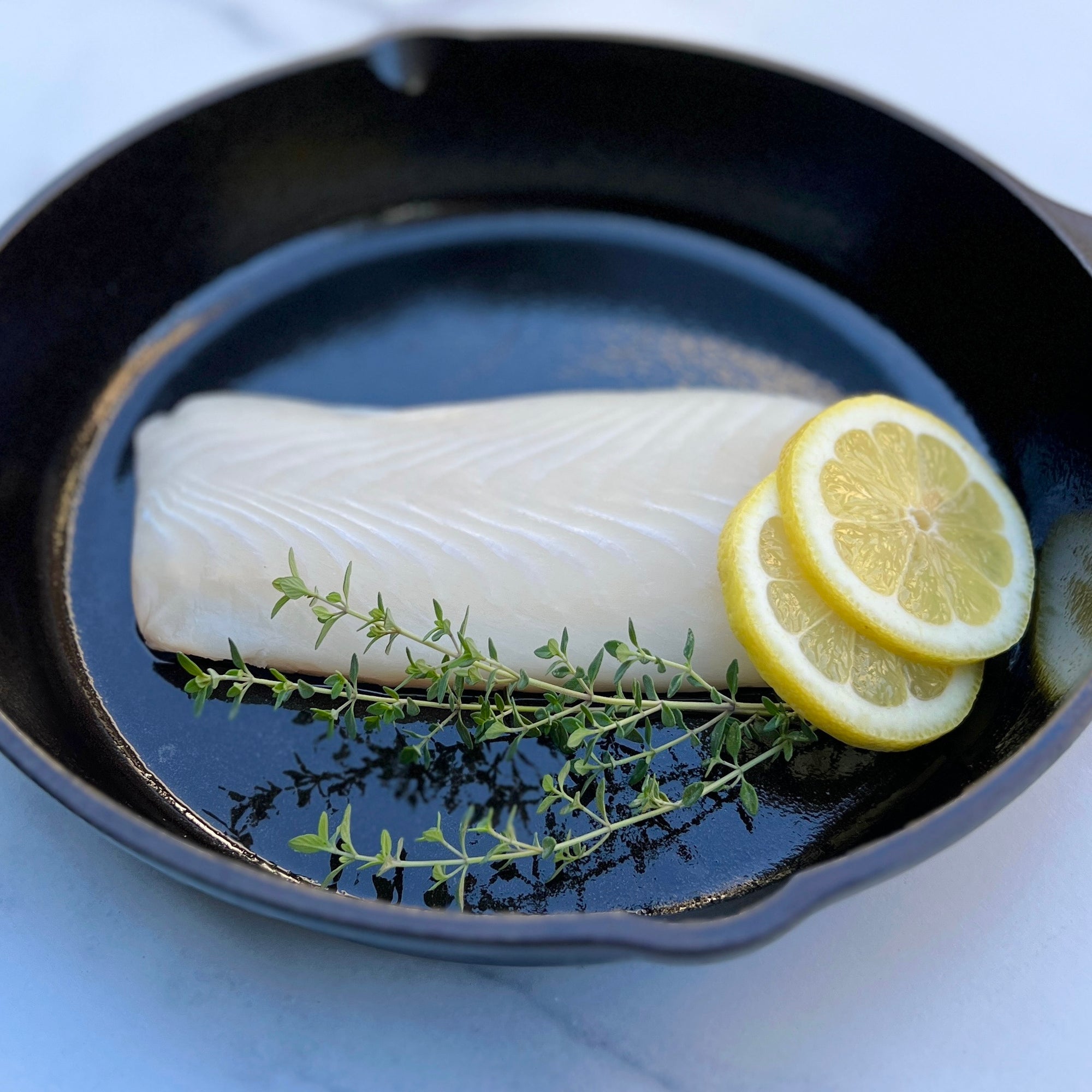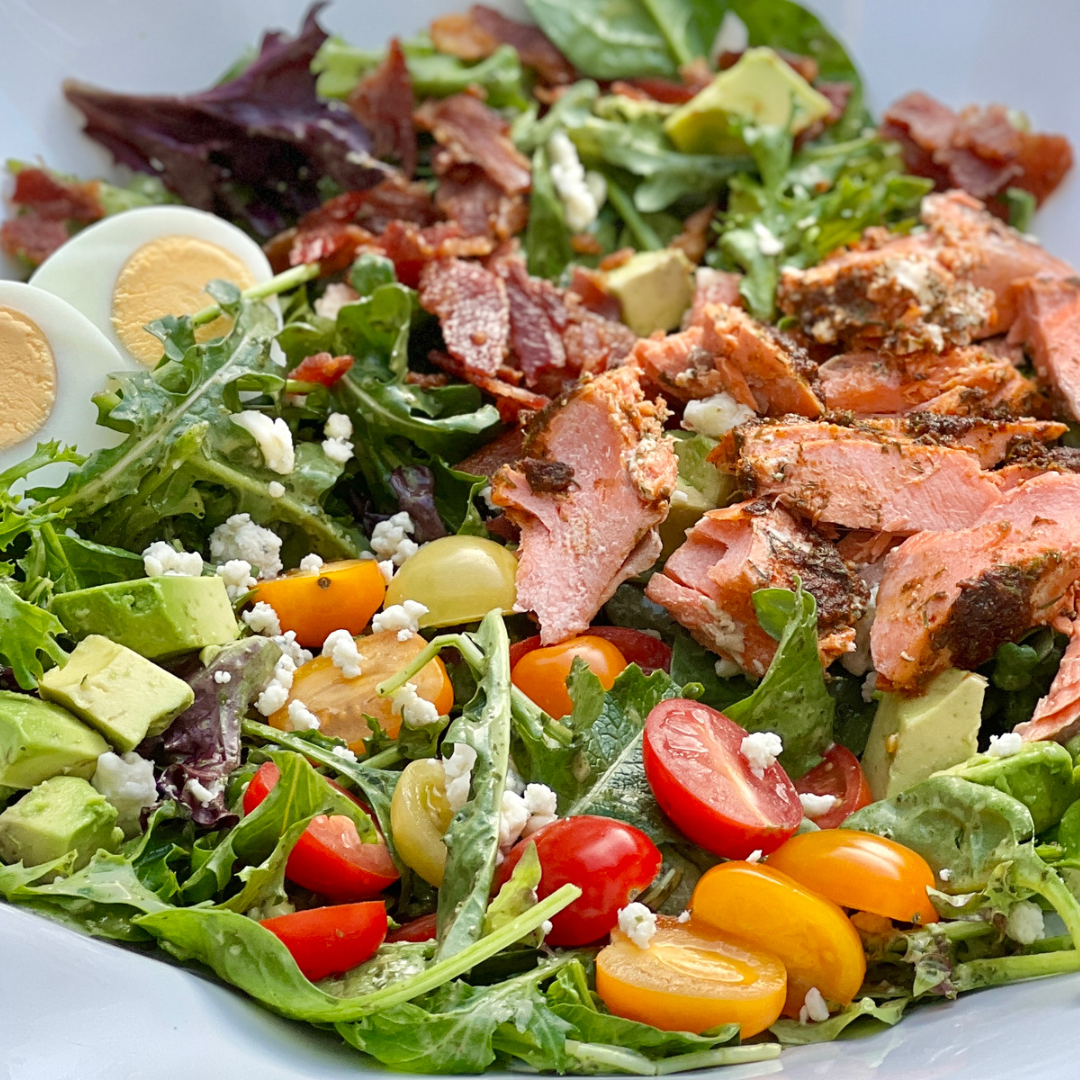YOUR GUIDE TO
Cooking Seafood

Cooking Premier Catch Seafood
We understand that preparing seafood can seem daunting, but it's actually easier than you think. We’re here to take the intimidation out of cooking seafood and help you achieve restaurant-quality texture and flavor at home. Explore our curated cooking guide below, crafted for each species and cooking method.
* Remember, your fish continues to cook even off the heat, especially when using high-heat methods such as pan-frying, broiling, or grilling. Remove your fish from heat a few degrees before your target temperature to account for carryover cooking.
Check out our comprehensive guide on Thawing Seafood.
Cooking Cod
The FDA recommends cooking cod until it reaches an internal temperature of 145°F (63°C) but this often results in dry fish. We have found cooking cod to 130°F is the best way to achieve a flaky, delicious texture.
Preheat your oven to 400°F (200°C). Place the cod filets in a baking dish. Brush with olive oil or melted butter and season with salt, pepper, and any other desired seasonings. Bake in the preheated oven for 12-15 minutes, or until the cod is cooked through and flakes easily with a fork.
Heat oil in a deep fryer or a large, deep pan to 375°F (190°C). Mix a batter using flour, salt, pepper, and beer or water. Dip the cod filets in the batter to coat them evenly. Carefully lower the battered cod filets into the hot oil and fry for 4-5 minutes, or until they are golden brown and crispy. Remove the fried cod from the oil and drain on paper towels to remove excess oil.
Preheat your grill to medium-high heat. Brush the cod filets with olive oil or melted butter and season with salt, pepper, and any other desired seasonings. Place the cod filets on the grill and cook for about 4-5 minutes per side, or until the fish is opaque and flakes easily with a fork.
Heat a non-stick skillet or pan over medium-high heat with a little olive oil. Brush the cod filets with olive oil or melted butter and season with salt, pepper, and any other desired seasonings. Place the cod filets in the pan and cook for about 3-4 minutes per side, or until the fish is golden brown and flakes easily with a fork.
Cooking Crab
Our Dungeness crab and king crab legs are fully cooked and then frozen. They are designed for you to simply thaw and eat.
The safest way to thaw your crab is under refrigeration. We recommend gently rinsing the crab legs under cold water and then placing them on a wire rack over a tray in the refrigerator for 6-8 hours, or overnight. This ensures thawing at safe temperatures.
Keep refrigerated until serving or preparing. We recommend consuming within 1-2 days of thawing.
Preheat the oven to 400°F. Toss crab with aromatics and oil, spread out on a sturdy roasting pan and roast for approximately 4 minutes until heated through, making sure to not overcook the meat.
Fill a large pot with 1 inch of water. Add aromatics like garlic, scallions, or herbs, if desired, and bring to a boil. Add crab, cover, and steam for about 4 minutes for thawed crab and about 8 minutes for frozen crab.
Separate the legs and brush with garlicky oil or your desired flavors. Grill over hot coals or high heat until the shells are lightly charred.
Cooking Halibut
The FDA recommends cooking halibut until it reaches an internal temperature of 145°F (63°C) but this often results in dry fish. We have found cooking halibut to 130°F is the best way to achieve a flaky, delicious texture.
Place the halibut filets in a baking dish. Brush with olive oil or melted butter and season with salt, pepper, and any other desired seasonings. Bake in the preheated oven for 12-15 minutes, or until the halibut is cooked through and flakes easily with a fork.
Preheat your grill to medium-high heat. Brush the halibut filets with olive oil or melted butter and season with salt, pepper, and any other desired seasonings. Place the halibut filets on the grill and cook for about 4-5 minutes per side, or until the fish is opaque and flakes easily with a fork.
Heat a non-stick skillet or pan over medium-high heat with a little olive oil. Brush the halibut filets with olive oil or melted butter and season with salt, pepper, and any other desired seasonings. Place the halibut filets in the pan and cook for about 3-4 minutes per side, or until the fish is golden and flakes easily with a fork.
Cooking Sablefish (Black Cod)
Sablefish, also known as black cod, is prized for its rich, buttery flavor and velvety texture. It is a fatty fish, which makes it forgiving and less likely to dry out during cooking. The FDA states that sablefish is done when it reaches an internal temperature of 145°F (63°C) but this often results in dry fish. To achieve the perfect doneness, we prefer to cook sablefish to an internal temperature of 130°F. This allows the fish to remain moist and tender.
Preheat your oven to 400°F. Place the black cod filets in a baking dish. Brush with olive oil or melted butter and season with salt, pepper, and any other desired seasonings. Bake in the preheated oven for 12-15 minutes, or until the black cod is cooked through and flakes easily with a fork.
Preheat your broiler. Place the black cod filets on a broiler pan or baking sheet. Brush with olive oil or melted butter and season with salt, pepper, and any other desired seasonings. Broil for about 5-7 minutes, or until the black cod is cooked through and the top is golden brown and slightly charred.
Heat a non-stick skillet or pan over medium-high heat with a little olive oil. Brush the black cod filets with olive oil or melted butter and season with salt, pepper, and any other desired seasonings. Place the black cod filets in the pan and cook for about 3-4 minutes per side, or until the fish is golden brown and flakes easily with a fork.
Fill a pot with a few inches of water and bring it to a simmer. Place the black cod filets in a steamer basket or on a plate that fits inside the pot without touching the water. Cover the pot and steam for about 8-10 minutes, or until the black cod is cooked through and flakes easily with a fork. You can season the fish with salt, pepper, and other desired seasonings before steaming, or add herbs and aromatics to the water for added flavor.
Cooking Salmon
The FDA states that salmon is done when it reaches an internal temperature of 145°F (63°C) but this often results in dry fish. We have found the sweet spot to be between 120-130°F depending on your desired texture. Salmon cooked to 120°F will be medium-rare and flake apart easily with a fork, while salmon cooked to 130°F or higher will be medium-done.
Preheat your air fryer to 400°F (200°C) for about 3-5 minutes. Place the salmon filets in the air fryer basket. Make sure they are not touching each other to allow for even cooking. Cook the salmon for 7-10 minutes. The cooking time may vary depending on the thickness of the filets and your air fryer model.
Place the salmon filets on a lightly greased baking sheet or in a baking dish. Bake in the preheated oven for 12-15 minutes, or until the salmon is cooked through and flakes easily with a fork. The cooking time may vary depending on the thickness of the filets
Preheat your grill to medium-high heat. Lightly oil the grill grates. Place the salmon filets on the grill, skin-side down. Grill for 6-8 minutes, then flip and grill for another 3-5 minutes, or until cooked through.
Heat a non-stick skillet or pan over medium-high heat with a little olive oil. Once hot, add the salmon filets skin-side down (if they have skin). Cook for 4-5 minutes, then flip and cook for another 3-4 minutes, or until cooked through
Cooking Scallops
Scallops should reach an internal temperature of 125°F to 130°F (52°C to 54°C) for a medium-rare to medium doneness. They should be slightly translucent in the center when done.
Pro-tips:
- Make sure your scallops are patted dry before cooking - you don't want any extra moisture in the pan.
- Avoid overcooking scallops, as they can become rubbery. They cook very quickly and should be removed from the heat as soon as they're done.
- When pan-frying, make sure not to overcrowd the pan to ensure a good sear.
Preheat your oven to 400°F (200°C). Pat the scallops dry and place them in a baking dish. Brush with olive oil or melted butter and season with salt, pepper, and any other desired seasonings. Bake in the preheated oven for 10-12 minutes, or until the scallops are opaque and slightly firm to the touch.
Heat oil in a deep fryer or a large, deep pan to 375°F (190°C). Pat the scallops dry. Carefully place the scallops into the hot oil and sear for 2-3 minutes, or until they are golden brown. Remove the scallops from the oil and drain on paper towels to remove excess oil.
Preheat your grill to medium-high heat. Pat the scallops dry with paper towels and brush them with olive oil or melted butter and season with salt and pepper. Place on hot grill for 2-3 minutes per side.
Heat a non-stick skillet or pan over high heat with a little olive oil. Pat the scallops dry and season with salt and pepper. Place the scallops in the pan and cook for about 1-2 minutes per side, until they have a nice sear and are opaque in the center.
Cooking Spot Prawns
Prawns will turn pink and opaque and be firm to the touch when done. They are delicate and cook quickly. Avoid overcooking, as this can result in a tough or rubbery texture.
Preheat your air fryer to 400°F (200°C). Toss the prawns in a bowl with olive oil or melted butter and season with salt, pepper, and any other desired seasonings. Place the prawns in the air fryer basket in a single layer. Cook for 4-6 minutes, shaking the basket halfway through, or until the prawns are pink and opaque.
Preheat your oven to 400°F (200°C). Arrange the prawns in a single layer on a baking sheet. Drizzle with olive oil or melted butter and season with salt, pepper, and any other desired seasonings. Bake in the preheated oven for 6-8 minutes, or until the prawns are pink and opaque.
Preheat your grill to medium-high heat. Toss the prawns in a bowl with olive oil or melted butter and season with salt, pepper, and any other desired seasonings. Thread the prawns onto skewers (if using) and place them on the grill. Cook for 2-3 minutes per side, or until they turn pink and opaque.
Heat a non-stick skillet or pan over medium-high heat with a little olive oil. Pat the prawns dry and season with salt and pepper. Add the prawns to the pan and cook for 2-3 minutes per side, or until they turn pink and opaque.
NEED INSPIRATION?
Visit the Premier Catch Kitchen
Featuring over 300 nutritious & delicious seafood recipes!
